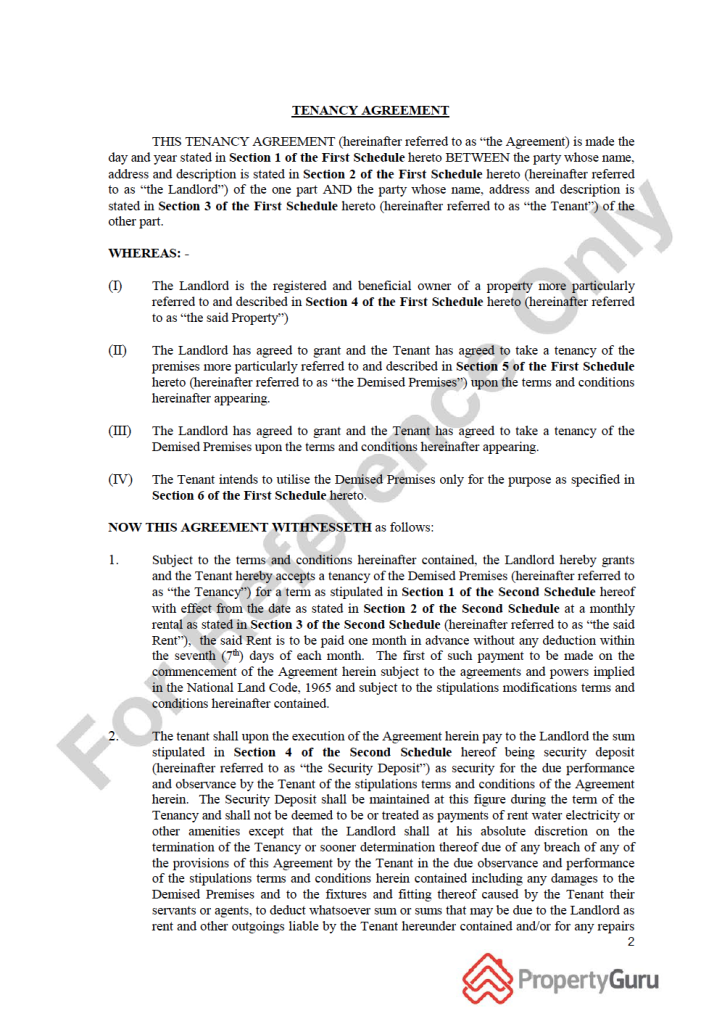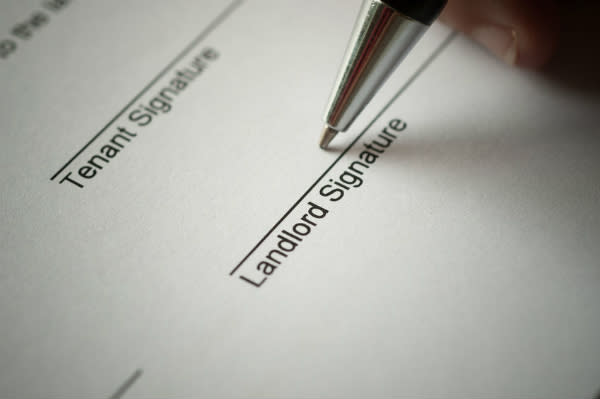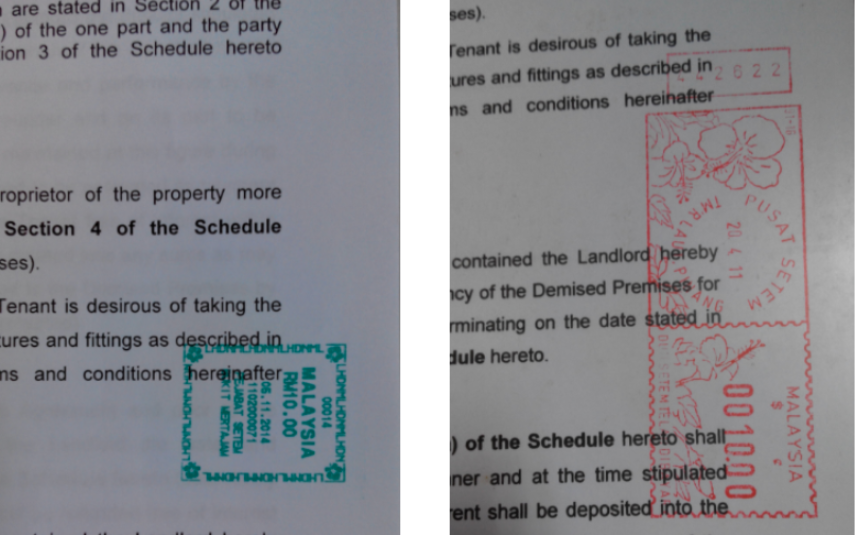Tenancy Agreement In Malaysia: Complete Guide And Sample Download

There are instances where verbal agreements are so much easier than creating a contract; and there are homeowners and property investors who rent out their premises based only on verbal agreements.
They seal the deal with a handshake, foregoing a written contract due to the complexity and added cost of consulting a legal expert.
While this practice is convenient and easy, it is strongly inadvisable because in case of any dispute, resolving legal disputes will get complicated.
This is particularly evident if the landlord and tenant have a conflicting recollection of the terms of rental.
Verbal contracts also often don’t cover some details like how much must the tenant pay if they damage or destroy the furniture or parts of the house.
What is a Tenancy Agreement?
This is a legal covenant between a landlord and tenant that outlines the duties and obligations of each party during the tenancy period.
It also provides a detailed description of the property being rented out, along with its furniture, fixture and other amenities.
To make the document as comprehensive as possible, landlords are advised to engage an attorney to draft a Tenancy Agreement, while potential tenants can consult their own lawyer to scrutinise the contract and ask for revisions before mutually agreeing to a final version.
However, hiring an attorney to create a tenancy contract can be costly, so many Malaysian landlords opt to draft their own tenancy agreement and ask would-be tenants to acquiesce to it.
Please note that currently there are no federal rules in Malaysia that regulate the scope and delimitation of a tenancy agreement.
This means either the landlord or the potential tenant can add many terms and conditions, making the contract more advantageous to either party.
Looking for a Rental Agreement Sample? Download your sample copy of Tenancy Agreement Malaysia here!
What should both parties include in their Rental Agreement?
There are many things that need to be specified in a tenancy contract. They should be carefully worded to make sure that the meaning is clear to avoid any misinterpretation.
But fundamentally, a Tenancy Agreement should include the following:
1. Property Details:
Indicate what kind of house is being leased and where it is located. In non-landed properties like condominiums, specify the unit number.
Also, make it clear if you’re renting out the entire flat or just a portion of it like a room.
It’s also advisable to indicate the state of the property – is it lacking fixtures, furniture and appliances?
Or will it come with such like refrigerator, air-conditioning unit and cooking ware? If the latter is true, the landlord needs to include an inventory in the agreement, and the tenant needs to confirm and reconfirm the existence and condition of these items before signing.
2. Rental Amount and Deposits:
State the exact monthly rent the tenant needs to pay, along with the payment’s due date and how it should be paid (e.g. cash, bank deposit, or wire transfer).
Also indicate the amount for the Earnest Deposit, Security Deposit and Utility Deposit.
3. Tenancy Period and Renewal Option:
The tenancy period is a fixed period of time which the tenant is renting the place. When drafting up the agreement, you need to be specific with the term and duration too.
The tenancy period usually covers a year-by-year basis. The most common are one-year, two-year and three-year periods.
This is because any rental for a period of more than three years is deemed a lease, not a tenancy. If you’re renting on a monthly basis, make sure to write that down instead.
Specify the date when the deal is signed as well as the starting date of the rental period and when it will it end.
You may also add clauses giving the tenant the right to renew or extend the tenancy for a certain period, subject to certain conditions.
4. Landlord’s Responsibilities:
These include payment of annual property tax to the relevant authorities; insure the property and pay insurance premiums; as well as make sure that the furniture and appliances provided are in good working condition.
If you’re the landlord, you will also want to be aware of another kind of tax aside from the annual property tax. This is rental income tax, where you as the landlord are taxed for money you make from renting out your properties.
Just as how you need to pay Real Property Gains Tax (RPGT) when you profit from selling a property, you need to pay rental income tax when you profit from renting out a property.
Good news though! You can claim a 50% income tax exemption on your rental income. This is subject to the following criteria:
Applicable for residential properties only
You must be a Malaysian resident individual
Rental income earned does not exceed RM2,000 per month per property
The property is rented under a legal tenancy agreement between owner and tenant
Tax exemption is given for a maximum period of 3 consecutive years of assessment
Effective for tenancies made in the year of assessment 2018 to 2020
5. Tenant’s Obligations:
These include paying the rent and utilities on time; maintain the furniture, appliances and interiors; informing the landlord of problems and structural defects, as well as abide with condominium rules and the landlord’s rules.
6. House Rules, Prohibitions and Limitations:
Outline what the tenant is not allowed to do. For instance, tenant is not permitted to sublet the premises or any part of it to a third party.
The unit can only be used for residential purpose, so the occupant cannot run a commercial business there.
Explicitly ban the conduct of vices and illegal activities like gambling and drugs, as well as not to do anything that will jeopardise the property’s insurance coverage.
Prohibit any renovation in the property. The landlord may also add limitations like the home can only be used by one family or a certain number of individuals.
7. How to Resolve Disputes:
This section contains the dispute resolution process, in the event that the tenancy agreement does not state some issues, or there are misinterpretations or misunderstandings between the landlord and tenant on certain clauses and terms in the contract.
What are the deposits tenants need to pay and how much do they cost?
Besides the monthly rent, landlords in Malaysia usually require tenants to pay the Earnest Deposit, Security Deposit and Utility Deposit.
1. Earnest Deposit
This is the money paid to reserve the rental unit so that the property owner won’t lease it to other would-be tenants for the next seven days. This is typically equivalent to one month’s rent, and can be kept in escrow by a real estate agent.

This is usually given to the landlord along with the tenant’s “letter of offer”, a one-page document that expresses the latter’s intention to rent a specified property. When the tenancy officially starts, the Earnest Deposit is usually utilised as rental payment for the first month of occupancy. NOTE: It may even be given back to the tenant, or considered as the Security Deposit.
2. Security Deposit
Consider this as a bond that will be waived in favour of the landlord in the event that the occupant breaches the tenancy agreement, like vacating the premises earlier than agreed. But if the tenant fulfils the contract and there are no issues throughout the tenancy, the entire amount is refunded when the tenancy ends. This is typically equivalent to two months’ worth of rent, and if the tenant runs away from the deal, this can be used as payment for cleaning and repairing damages, as well as replacing fittings, appliances and keys.
3. Utility Deposit
Its purpose is to pay any outstanding utility bills that have not been paid at the end of the tenancy period, like water, power, gas and sewerage. In Malaysia, this is typically 50% of the rental rate for one month (although there are some cases where the landlord may choose to collect one month’s rental, if the half month amount is too low). IMPORTANT: Please note that the Security Deposit and Utility Deposit are given to the landlord upon inking of the Tenancy Agreement.
How much does the Stamp Duty for a Tenancy Agreement cost?
When the landlord and tenant are both satisfied with the tenancy contract, both of them need to sign it as well as all pages of the agreement.
Each party also needs a witness to ink the deal as well as all of its pages. Although both parties have signed the deal, it is still not yet a legally binding document or admissible in court unless it is stamped by the Malaysia Inland Revenue Authority or Lembaga Hasil Dalam Negeri Malaysia (LHDN).
But before it is sealed by LHDN, you need pay the Stamp Duty. Here, you may wonder: “who is liable for stamp duty?” The landlord, or the tenant? In Malaysia, the tenant pays for the stamp duty fees – not the landlord/seller. This is laid out in the third schedule of Stamp Act 1949.
If you’re still unclear on stamp duty, check out our stamp duty guide here. Accordingly, you will be asked by staff at the nearest LHDN office to submit two application forms – PDS 1 and PDS 49(A).
Basically, the Stamp Duty for Tenancy Agreements spanning less than one year is RM1 for every RM250 of the annual rent in excess of RM2,400.
For contracts that are signed for anywhere between 1 to 3 years, the stamp duty rate is RM2 for every RM250 of the annual rent in excess of RM2,400.
And if the Tenancy Agreement has been signed for more than 3 years, the stamp duty rate will be RM3 for every RM250 of the annual rent in excess of RM2,400.
For instance, the monthly rental for a one-year tenancy is RM2,000, so the annual rent is RM24,000. The formula for calculating that Stamp Duty will be: RM24,000 – RM2,400 = RM21,600 RM21,600/250 X RM1 = RM86.4 in Stamp Duty Experts say that it is advisable to ask the staff at LHDN to stamp the respective original copies of the tenancy contract for the landlord and tenant, as well as property agent if one brokered the rental deal.
Stamp duty aside, what other fees are involved in the rental agreement?
Two other fees you should take into account when drafting your tenancy agreement are the administration fees and legal fees. The administration fees are a one-time charge based on the monthly rental amount. Once again, this fee is paid by the tenant to the seller. Below are the general recommended guidelines for admin fees, though the final amount is up to the discretion of the landlord or real estate agency.
Rental Per Month | Estimated Admin Fees |
< RM1,000 | RM100 |
> RM1,000 to RM1,999 | RM150 |
> RM2,000 to RM3,000 | RM200 |
> RM3,000 to RM4,000 | RM250 |
> RM4,000 | RM300 |
How to calculate legal fees for tenancy agreement in Malaysia
Other than the admin fees and actual rental amount, there are other fees before a tenancy can be finalised, especially at the beginning – the legal fees. Slightly different from stamp duty and admin fees, legal fees categorically depend on the duration of the tenancy, by which the baseline is 3 years (either less or more than 3 years). Here’s a rough guideline: If the rental period is less than three years, the legal fees payable is as below:
For the first RM10,000 of annual rent: 25% of the monthly rent
For the next RM90,000 of annual rent: 20% of the monthly rent
Where the annual rent is in excess of RM100,000: Negotiable
If the rental period is more than three years (lease), the legal fees payable are as below:
For first RM10,000 of annual rent: 50% of the monthly rent
For the next RM90,000 of annual rent: 20% of the monthly rent
Where annual rent is in excess of RM100,000: Negotiable
For legal fees, it’s customary in Malaysia for both tenant and landlord to split it as they see fit, rather than the tenant bearing the entire charge.
[ArticleCallout]{ “title”: “Stamp Duty And Administration Fee: 2 Important Aspects For Tenancy Agreement In Malaysia”, “excerpt”: “This is a piece of legal document that clearly outlines the duties and responsibilities of both parties, as long as the tenant is still living within the premises.”, “link”: “https://www.propertyguru.com.my/property-guides/stamp-duty-and-administration-fee-for-tenancy-agreement-28223”, “image”: “https://img.iproperty.com.my/angel-legacy/1110×624-crop/static/2020/06/sd-ac-ta-main-image.jpg” } [/ArticleCallout]
Below is an example of stamped Tenancy Agreement samples:
All in all, the structure of your Tenancy Agreement should be sectioned as:
A cover page detailing the date, landlord and tenant’s details (names, IC numbers).
Establishment of the terms in the agreement: Who will be addressed as landlord, tenant, as well as the premises.
Specifications of duration of the tenancy, deposits and rental amount.
Details of tenant’s responsibilities and obligations such as on-time rent payment, settling utility bills, ensuring the premise is undamaged, etc.
Details of landlord’s responsibilities and obligations such as making sure the house is insured, tax payment, etc.
Specified special conditions or clauses that is agreed by landlord and tenant when occurs cases of exceptions.
Final definitions of terms such as “tenant”, “landlord”, rental amount, duration of stay, etc.
Signatures of the landlord, tenant, as well as witnesses.
Description of other pertinent information such as the actual property address, contact details of the parties and other tenancy terms and conditions. This section is usually addressed as Schedule.
List of the inventory of the items supplied by the landlord of which are anticipated to be returned in working condition.
For a quick and easy guide, below is the typical rental process in Malaysia:
Once you’ve identified your best possible prospect (either through an agent or on your own), it is important to view the property. At this point, you are able to check the property and see if it is the right one for you.
Negotiate. You’ll be given the rental rate, and before you confirm the amount (the total as well as the needed deposits), it probably wouldn’t hurt to negotiate.
When you’ve made your decision, the landlord will issue a “Letter of Offer” and you, the tenant, will produce an Earnest Deposit.
Within 7-14 days of paying the Earnest Deposit, both landlord and tenant will prepare and sign the Tenancy agreement (with witnesses). Here is also where the Security and Utility deposits will be put down.
The signed Tenancy Agreement will then be stamped by the Inland Revenue Board of Malaysia (LHDN). Both tenant and landlord should have a copy of the stamped agreement.
Now, you get the keys to the house handed over! Yay! Keep in mind that it is advisable to inform the landlord of any damages that you might have missed during the viewing.
Relevant Guides:







